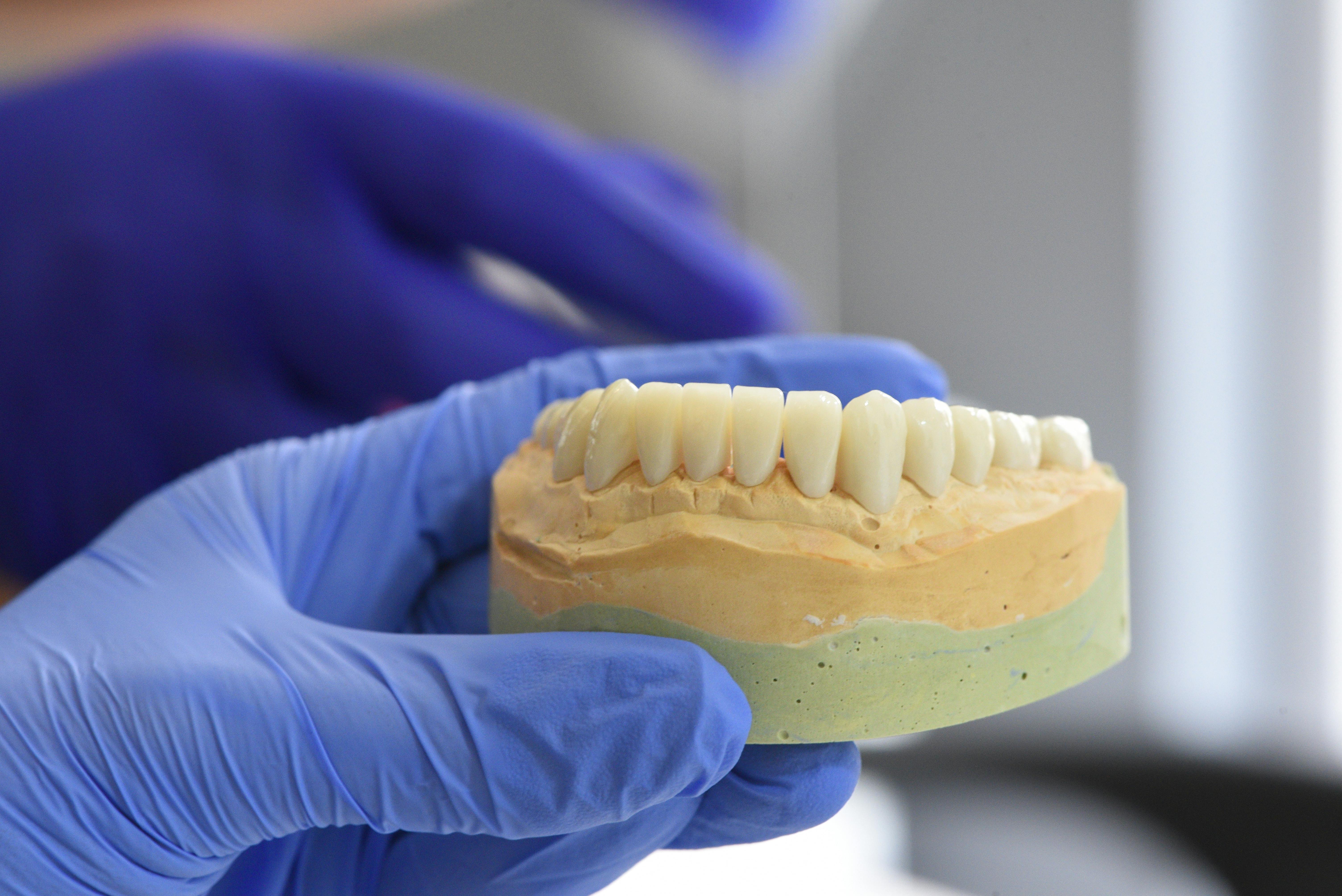Misaligned teeth can cause a variety of problems, including temporomandibular joint (TMJ) disorder. TMJ disorder is a painful condition that affects the jaw joint and muscles. It can lead to difficulty chewing, jaw pain, headaches, and even neck pain. If left untreated, TMJ disorder can become more severe and cause long-term problems. Fortunately, there are ways to identify and treat misaligned teeth that may be contributing to TMJ disorder. In this article, we’ll discuss how misaligned teeth can lead to TMJ and what you can do about it.Yes, misaligned teeth can cause TMJ. When the teeth are not properly aligned, the jaw is forced to move in ways that it was not designed for. This can cause stress on the joint and lead to a condition called temporomandibular joint disorder (TMJ). Symptoms of TMJ include headaches, jaw pain, clicking or popping noises when opening and closing the mouth, and difficulty chewing. Treatments for TMJ due to misaligned teeth may include orthodontic treatment to correct the alignment of the teeth as well as physical therapy, medications, and other treatments.
How Does Misalignment Affect the Jaw Joints?
Misalignment of the jaw joints can lead to a variety of problems, including pain, difficulty chewing, clicking or popping of the jaw, grinding or clenching of the teeth, and headaches. When the temporomandibular joint (TMJ) is misaligned, it can cause the muscles in the jaw and neck to be forced to work harder than they should. This can lead to tension and tightness in the muscles of the face, neck, and shoulders. It can also cause damage to the joint itself due to overuse. When this happens, it can lead to increased wear and tear on the cartilage that lines the joint, resulting in pain and decreased range of motion. Treatment for TMJ misalignment usually involves physical therapy or surgery in order to restore normal function. In some cases, orthodontic treatment may be recommended in order to correct any structural issues that are causing or contributing to misalignment.
Misalignment of the jaw joints can also have an effect on dental health by preventing proper alignment of teeth. This can cause difficulty when brushing or flossing as well as an increased risk for cavities and other dental problems. Orthodontic treatment may be necessary in order to correct any misalignment issues that are contributing to these problems. In addition, a mouth guard may be recommended in order prevent grinding or clenching during sleep which could further aggravate any misalignment issues.
Overall, misalignment of the jaw joints can have serious implications for both oral health and overall comfort levels. Proper diagnosis is essential in order to determine what type of treatment is needed in order restore proper alignment and reduce symptoms caused by TMJ dysfunction.
Symptoms of TMJ
TMJ, or temporomandibular joint disorder, is a condition that affects the jaw joint and muscles in the face. It can cause a variety of symptoms, including pain in the jaw joint and surrounding area, difficulty chewing, clicking or popping noises when opening or closing the mouth, locking of the jaw, and headaches. TMJ can also lead to long-term damage to the teeth and gums if left untreated. Pain is often felt in the face, neck, and shoulders. Other symptoms may include dizziness, earaches or ringing in the ears (tinnitus), muscle spasms in the face, trouble sleeping due to pain or discomfort from clenching or grinding teeth (bruxism), and facial swelling. It is important to seek medical help if any of these symptoms are present as they could be related to other medical conditions as well.
What Causes Teeth to Become Misaligned?
Misalignment of teeth, known as malocclusion, can be caused by a variety of different factors. One of the most common causes is genetics. If one or both of your parents have misaligned teeth, it’s likely that you may also have them. Other causes of malocclusion include missing or extra teeth, thumb sucking, and improper jaw growth due to childhood habits such as prolonged pacifier use or tongue thrusting. In some cases, misalignment can be caused by trauma to the mouth or face from an accident or injury.
Misaligned teeth can also occur if the upper and lower jaws do not fit together properly. This is known as a skeletal discrepancy and can be caused by a number of factors, including genetics, trauma to the mouth or face, and developmental issues such as cleft palate. In some cases, a skeletal discrepancy may be caused by an incorrect bite due to improper orthodontic treatment.
Finally, misalignment can be caused by poor oral hygiene habits such as not brushing and flossing regularly or not wearing a mouthguard during sports activities. Poor oral hygiene can lead to the buildup of plaque on the teeth which can cause them to become crooked over time. Additionally, poor oral hygiene habits can lead to gum disease which can also contribute to misalignment of the teeth.
How Can Orthodontic Treatment Help with TMJ?
TMJ, or temporomandibular joint disorder, is a medical condition that affects the jaw joint and can cause a wide variety of symptoms, including pain, limited jaw movement, headaches, and jaw clicking. Orthodontic treatment can help alleviate these symptoms by providing a proper bite alignment to reduce stress on the temporomandibular joint.
Orthodontic treatment can help to restore the correct alignment of the teeth and improve the overall function of the jaw. An orthodontist will assess your bite pattern and identify any areas where there is misalignment or improper contact between the teeth. Once this is determined, they will create an individualized treatment plan to correct the misalignment and improve your bite.
In addition to improving your bite alignment, orthodontic treatment can also help to reduce tension in the jaw muscles that often accompany TMJ symptoms. By properly aligning your teeth, you can reduce strain on the muscles of your jaw and decrease any discomfort or pain you may be experiencing from TMJ.
Orthodontic treatment is a safe and effective way to treat TMJ symptoms and help you achieve a healthy bite alignment. If you are experiencing symptoms of TMJ or have noticed changes in your bite pattern, it is important to consult with an experienced orthodontist who can assess your condition and create an individualized treatment plan that will provide lasting relief from your symptoms.

Treatments for TMJ
TMJ, or temporomandibular joint disorder, is a condition that affects the joints connecting the jaw to the skull. It can cause pain and discomfort, and can have a significant impact on quality of life. Fortunately, there are a range of treatments available for TMJ. These treatments vary in effectiveness and may include lifestyle changes, medications, physical therapy, surgery or complementary therapies such as acupuncture.
Lifestyle changes can help reduce symptoms of TMJ and may include avoiding activities that make symptoms worse (such as opening the mouth wide), eating softer foods and avoiding chewing gum. Medications such as muscle relaxants or anti-inflammatory drugs may be prescribed to reduce pain and inflammation. Physical therapy can also help improve joint function and reduce painful symptoms. This may include stretching exercises or massage to relax the muscles around the jaw.
In some cases, surgery may be recommended to correct any structural problems with the jaw joint or surrounding muscles. Surgery is usually only considered if other treatments have not been successful in relieving symptoms. Finally, complementary therapies such as acupuncture have been shown to be effective in some cases for reducing pain and improving joint function in people with TMJ disorder.
How Does a Dentist Diagnose TMJ?
When diagnosing temporomandibular joint (TMJ) disorder, a dentist will typically begin by taking a thorough medical history. The dentist will ask the patient about any previous injuries or trauma to the jaw, as well as any signs and symptoms they are experiencing. The dentist will also assess the patient’s jaw alignment and muscle movement in both the open and closed positions. In some cases, an x-ray may be taken to check for structural abnormalities or damage to the jaw joint.
The dentist may also use diagnostic imaging such as MRI or CT scans to get a better view of the jaw joint and its surrounding structures. This can help identify any areas of inflammation or damage that may be causing pain or dysfunction. Blood tests may also be ordered to rule out other conditions that could be causing the symptoms, such as arthritis or an infection.
In addition, the dentist may perform an electromyography (EMG) test to measure muscle activity in the jaw area while speaking or chewing. This test can help determine if there is any nerve damage or other neurological issues that could be contributing to TMJ disorder.
Once all of these tests have been completed, the dentist will review them and make a diagnosis based on their findings. If TMJ disorder is identified, they will create a treatment plan tailored to each individual’s needs and goals. Treatment options range from lifestyle modifications and physical therapy exercises to orthodontic appliances and surgery in more severe cases.
Are There Any Complications of Uncorrected TMJ?
Left untreated, temporomandibular joint dysfunction (TMJ) can lead to a variety of complications. TMJ is a common disorder that affects the jaw joint and surrounding muscles, and is often caused by an injury to the joint or the surrounding muscles. Over time, the condition can become worse, leading to more severe symptoms and potential complications. Common complications of uncorrected TMJ include jaw pain, headaches, neck pain, difficulty chewing or speaking, earache and hearing problems. In some cases, TMJ can even lead to facial paralysis or ankylosis (stiffening of the jaw). If left untreated for too long, TMJ can also cause permanent damage to the joint and surrounding muscles.
TMJ can also lead to other issues that don’t involve the jaw itself. For example, people with TMJ may experience sleep disturbances due to pain or discomfort in their jaw. They may also suffer from depression or anxiety due to the chronic nature of their condition. It is important to seek treatment for TMJ as soon as possible in order to prevent further complications from arising.
Treatment for TMJ usually involves lifestyle changes such as avoiding chewy or hard foods and avoiding extreme jaw movements such as wide yawning or gum chewing. In some cases, physical therapy may be recommended in order to help stretch and relax tight muscles around the jaw joint. In more severe cases, medications such as anti-inflammatories or muscle relaxants may be prescribed by a doctor. Surgery may be necessary in extreme cases where there is significant damage to the joint itself. With proper treatment and management of symptoms, many people with TMJ are able to live relatively normal lives without suffering from any permanent damage due to their condition.

Conclusion
Misaligned teeth can be a contributing factor to TMJ, but there is no absolute consensus as to its effects. While it may be the case that misaligned teeth can put additional strain on the TMJ and lead to increased pain and discomfort, other factors such as genetics, age, stress, injury, or poor posture can all contribute to the development of TMJ. It is therefore important to consider all possible causes when diagnosing and treating TMJ.
It is important for those with misaligned teeth to seek professional dental care in order to maintain proper oral health and reduce the risk of developing TMJ. If TMJ symptoms do arise, it is important for sufferers to seek professional medical advice in order to receive an accurate diagnosis and appropriate treatment plan.
